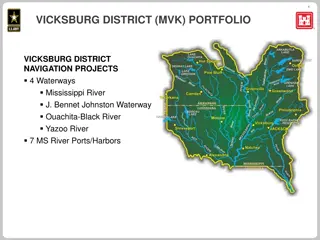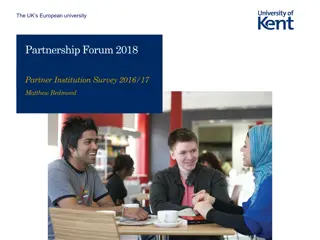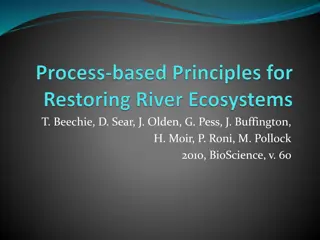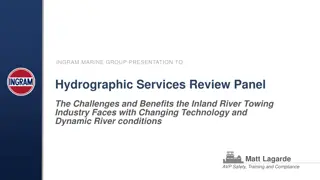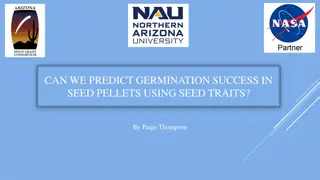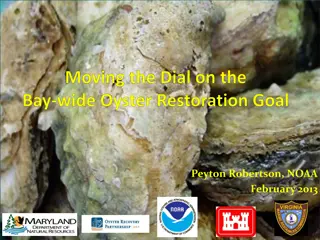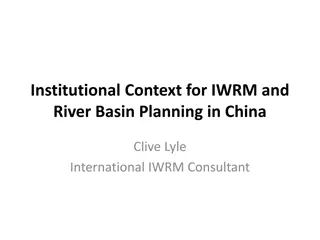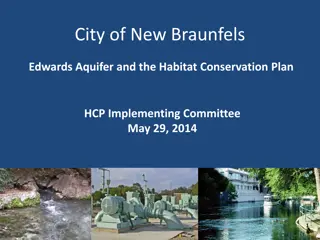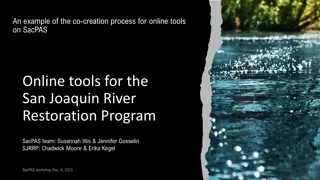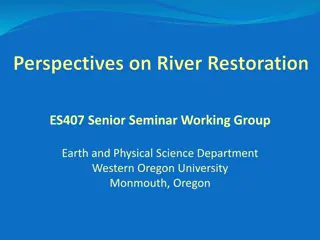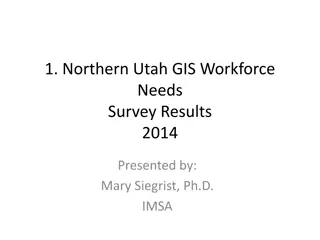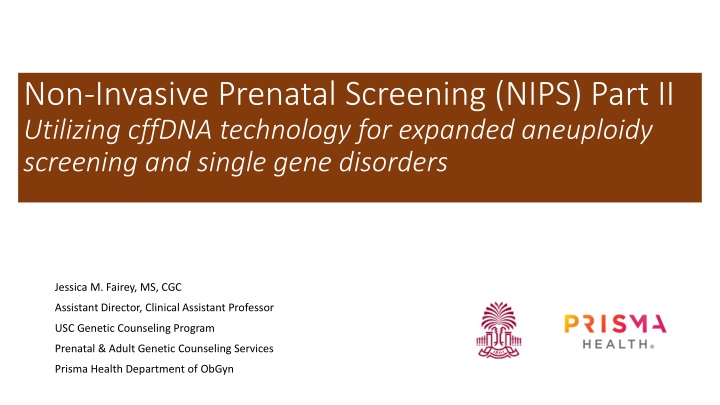
Survey Results on U.S. River Restoration Practices
Broadening efforts to evaluate and synthesize river restoration projects in the United States. A comprehensive survey sheds light on the varying success levels and approaches used in over 300 unique projects. The study aims to inform future endeavors and enhance the understanding of river restoration nationwide.
Download Presentation

Please find below an Image/Link to download the presentation.
The content on the website is provided AS IS for your information and personal use only. It may not be sold, licensed, or shared on other websites without obtaining consent from the author. If you encounter any issues during the download, it is possible that the publisher has removed the file from their server.
You are allowed to download the files provided on this website for personal or commercial use, subject to the condition that they are used lawfully. All files are the property of their respective owners.
The content on the website is provided AS IS for your information and personal use only. It may not be sold, licensed, or shared on other websites without obtaining consent from the author.
E N D
Presentation Transcript
Non-Invasive Prenatal Screening (NIPS) Part II Utilizing cffDNA technology for expanded aneuploidy screening and single gene disorders Jessica M. Fairey, MS, CGC Assistant Director, Clinical Assistant Professor USC Genetic Counseling Program Prenatal & Adult Genetic Counseling Services Prisma Health Department of ObGyn
Conflict of Interest Statement No conflicts to declare Discussion of labs is based on personal clinical experience
Most sensitive and specific screening test for common aneuploidies (trisomies 13,18,21) Lowest false positive rate Noninvasive Prenatal Screening (NIPS) Only screening test for fetal sex aneuploidies Early gestational age allows for optimal patient decision making Risk assessment NOT diagnostic Dependent upon fetal fraction
Expanded NIPS MaterniT Genome (LabCorp) Screens for 23 WHOLE chromosome abnormalities Screens for copy number variants (CNVs) > 7 Mb NOT diagnostic Reflex option CONSIDERATIONS Nonspecific findings on ultrasound for patients not undergoing prenatal diagnosis Parental translocation, LARGE ENOUGH, to be detected Highly anxious families
Expanded NIPS Limitations Does not interrogate ALL chromosome material Risk assessment is limited to LARGE deletions/duplications of chromosome material Residual Risk PPV difficult to calculate due to low prevalence of CNVs Does not screen for NTDs Offer MSAFP only after 15w Results may represent chromosomal changes from Mother Placental mosaicism Fetal mosaicism Vanished twin
Birth Defect Etiologies 97% Normal 40 60% 3% Defects 20 25% 10 15% 8 12% 2 10% Chromosomal Prenatal Exposure Single-gene Multifactorial Unknown Adapted from Stevenson, RE and Hall, J. Human Malformations and Related Anomalies, 2nd ed. Oxford University Press, Oxford, 2006
Autosomal Dominant Inheritance Genomics Education Programme
Autosomal Recessive Inheritance Genomics Education Programme
Single gene NIPS Vistara (Natera) 25 autosomal dominant conditions Sensitivity/specificity is gene specific Increased incidence of de novo mutations in curated gene list Select conditions with third trimester ultrasound findings, nonspecific findings or no findings Considerations Advanced paternal age Paternal family history Variable expression for some conditions (i.e. Noonan) Mother cannot be affected Late gestation ultrasound findings for patients not undergoing prenatal diagnosis Craniosynostoses Skeletal dysplasias
Single gene NIPS Unity (BillionToOne) 4 autosomal recessive genes HBB, HBA, CFTR, SMN1 Carrier screening w/ reflex to single gene NIPS Paternal sample not needed for fetal risk assessment Will not predict carrier status of fetus Considerations Patient is known carrier for CF, SMA, hemoglobinopathy and partner is unavailable At risk couple not undergoing prenatal diagnosis Residual risk may be difficult to interpret provides increased or reduced risk for recessive condition
Carrier is an individual heterozygous for a pathogenic or likely pathogenic variant in an autosomal recessive or X linked gene Carriers for autosomal recessive conditions typically do not manifest Carriers for X linked conditions may manifest differently than offspring Preconception screening is ideal Consanguineous couples are at increased risk for autosomal recessive conditions Carrier screening does not report variants of uncertain significance. Genetic Carrier Screening
Ethnic-specific, panethnic, and larger panels are acceptable strategies Consider carrier frequencies for guidance All patients should be offered screening for CF, SMA and hemoglobinopathies ACOG Committee Opinion 690, March 2017, Reaffirmed 2020 CBC + hemoglobin electrophoresis to screen for thalassemias Negative carrier screening reduces the chance to be a carrier Risk cannot be eliminated For carriers, reproductive partners should be offered screening Consider testing strategy / referral to genetic counseling Genetic counseling referral: Consanguineous couples Carrier couples Family history of genetic disorders
Cystic Fibrosis Case Utilizing sgNIPS Initial Consult: 33 year old G3P1011 first child diagnosed with cystic fibrosis on NBS Elevated IRT molecular analysis positive sweat test Negative family history Carrier screening performed in 2019 to confirm carrier status following son s diagnosis
Fathers carrier screen result Mother s carrier screen result No other pathogenic variants were detected in the genes that were screened.
Current pregnancy: Patient elects Unity Screen Current pregnancy: Patient elects Unity Screen 1) Carrier Screening: Patient was found to be COMPOUND HETEROZYGOUS Known pathogenic F508del and a newly identified likely pathogenic variant: c.2657+2_2657+3insA 2) Reflex to sgNIPS: Reduced Fetal Risk
Through linkage analysis, determined that the mothers variants are on two separate chromosomes (trans), confirming a molecular diagnosis of Cystic Fibrosis recurrence risk adjusted from 25% to 50% !
Follow Up Why was this missed on carrier screening performed on the patient in 2019? Carrier screening does not report variants of uncertain significance on carrier screening panels Requested reanalysis of carrier screening Variant had been reclassified within the past year Confirmed to now be reported What does this now mean for the patient?



